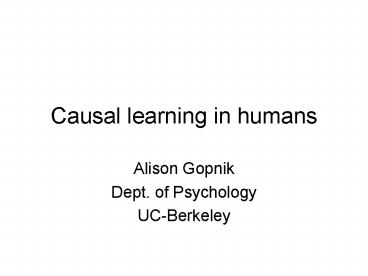Causal learning in humans - PowerPoint PPT Presentation
1 / 20
Title:
Causal learning in humans
Description:
Substantive Assumptions and Perceptual Causality ... of some infatuation with the current account of computation and neurology. ... – PowerPoint PPT presentation
Number of Views:36
Avg rating:3.0/5.0
Title: Causal learning in humans
1
Causal learning in humans
- Alison Gopnik
- Dept. of Psychology
- UC-Berkeley
2
Knowledge as an inverse problem
- East Coast Solutions
- Structured
- Abstract
- Innate
- Domain-specific
- Modularity
- West Coast Solutions
- Distributed
- Concrete
- Learned
- Domain-General
- Connectionism
3
The inverse problem of causal knowledge
- Structured
- Coherent
- Abstract
- Complex
- Solution
- Mechanism
- Novel
- Learned
- Related to conditional probabilities
- Solution Associationism
4
The Mechanistic Solution
- Substantive Assumptions and Perceptual Causality
- In adults Michotte, 1962 Scholl Tremoulet,
2002 Heider, 1958, - In children Bullock et al. 1982 Shultz, 1982
- In infants Leslie, 1987 Oakes and Cohen, 1990
Watson, 1987 Meltzoff, 1988
5
The Associationist Solution
- Formal Assumptions and Contingencies
- In animals
- Rescorla-Wagner, Classical and Operant
Conditioning - In adults
- Shanks, 1985 Shanks Dickinson, 1987 Cheng
Novick, 1992 - In children?
6
Limits of Earlier Work
- Causes and effects specified beforehand
- Causal strength rather than causal structure
- No distinction or integration between
intervention and observation - No intermediate causes
- No unobserved causes
7
The theory theory
- In adult categorization - Murphy and Medin, 1985
- In infants and children
- Folk Psychology - Gopnik, 1988, Gopnik
Wellman, 1994 - Folk Biology- Carey, 1986, Gelman Wellman,
1992, - Folk Physics - Carey et al. 1988, Gopnik, 1988
8
Features of the Theory Theory
- Static Features
- Abstract, coherent, causal entities and rules,
including unobserved entities - Functional Features
- Provides predictions, interpretations, and
explanations - Dynamic Features
- Changes in the light of new evidence and
experimentation
9
- . Far too often in the past psychologists have
been willing to abandon their own autonomous
theorizing because of some infatuation with the
current account of computation and neurology. We
wake up one morning and discover that the account
that looked so promising and scientific S-R
connections, gestaltist field theory, Hebbian
cell assemblies has vanished and we have spent
another couple of decades trying to accommodate
our psychological theories to it. We should
summon up our self-esteem and be more
stand-offish in future (Gopnik Meltzoff,
1997).
10
Bayes Nets to the Rescue
- Representation
- Coherent, complex causal entities and rules
including unobserved entities, and integrating
intervention and observation. - Inference
- Normative algorithms for prediction, intervention
and explanation - Learning
- Normative algorithms for learning causal
structure from data and experimentation
11
Normative Mathematical Solutions to Inverse
Problems
- Vision
- 3-d representations of objects
- Projections of objects onto 2-d surfaces
- 2-d surfaces are the result of 3-d projections
- Causation
- Acyclic directed graphs
- Projections from graphs to probability
distributions (Markov) - Probability distributions are the result of
projections (Faithfulness)
12
Chengs Causal Powers
- Patricia Cheng Psychological Review 1997.
- Causal powers rather than association
- Representation equivalent to a Bayes-net noisy-or
or noisy-and gate with no unobserved common
causes - Normative learning procedure for deriving causal
power from conditional probability
13
Limitations of Chengs Theory
- Causes and effects specified beforehand
- Causal strength rather than causal structure
- No intermediate causes (causal chains)
- No inference of unobserved causes
- No distinction between intervention and
observation
14
Recent Empirical Work with Bayes Nets in Adults
- Extensions of Cheng
- Inhibitory causes and interactive causes (Novick
Cheng, in press). - Chains and unobserved common causes
- Glymour 2002
15
Recent Empirical Work With Bayes Nets in Adults
- Prediction and categorization in adults
- Waldmann Martignon, 1998, Waldmann Hagmeyer,
2001, Rheder Hastie, 2001 - Bayes Net representations to describe adult
causal predictions and categorizations - Different complex causal structures lead to
different predictions and categorizations
16
Recent Empirical Work With Bayes Nets in Adults
- Learning complex causal structure from
observation in adults? - Steyvers, Tenenbaum et al (submitted)
- Danks (submitted)
- Lagnado Sloman, 2002
- Individual variability
17
Recent Empirical Work With Bayes Nets in Adults
- Learning complex causal structure from
interventions and observations in adults. - Schulz, 2002 Gopnik et al. In press.
- Steyvers et al. submitted
18
Empirical Work with Bayes Nets in 3-4 Year Old
Children
- Gopnik, Glymour, Sobel, Schulz, Kushnir
Danks, Psychological Review, in press. - Categorization - Gopnik Sobel 2000
- Learning from conditional dependence - Gopnik,
Sobel Schulz Glymour, 2001 Sobel, Tenenbaum
Gopnik, submitted - Learning from intervention and conditional
dependence - Gopnik et al. In press - Inferring unobserved causes - Gopnik et al. In
press.
19
New Empirical Questions
- Probabilistic learning
- Statistical representativeness
- Interactions and Boolean combinations
- Unobserved variables
- Interactions with other types of knowledge
20
New Computational Questions
- Processing and memory constraints
- Data-mining versus bootstrapping
- Determining and reorganizing variables
- Conceptual change































